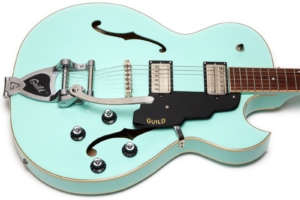 Here we have a 2020 Guild Starfire I SC (single cut) in Seafoam Green that I absolutely had to have based on the color alone.
Here we have a 2020 Guild Starfire I SC (single cut) in Seafoam Green that I absolutely had to have based on the color alone.
There is a fair bit of stir in the online guitar forums about these Starfire I guitars, most of which revolves around the question, how is Guild making these for such a low price? This guitar has a street price of $599 new! In 2020! Hell a similarly equipped Newark St. Starfire III (which is sort of what this should be called – more on that later) has an MSRP of almost double that of this one ($1,555 vs. $835 in May 2020). So how are they doing this? Cheaper parts? Cheaper wood? Cheaper labor? There are only so many ways to lower production costs, so grab a cocktail while I tear this guitar open to see how they made it so inexpensive in a world where the price of everything is soaring.
Introduction
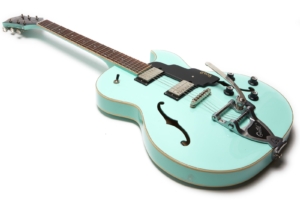 Guild has a storied history of being terrible at naming things, or should I say they’re famous for renaming things in a way that just confuses everyone. Over the years they’ve done it with acoustics, they’ve done it with electrics, and they’ve done it with pickups. So it’s kind of a tradition at this point when I say, “What the hell is up with these Starfire I guitars?”
Guild has a storied history of being terrible at naming things, or should I say they’re famous for renaming things in a way that just confuses everyone. Over the years they’ve done it with acoustics, they’ve done it with electrics, and they’ve done it with pickups. So it’s kind of a tradition at this point when I say, “What the hell is up with these Starfire I guitars?”
What’s up indeed! To set the stage, let’s talk some History.
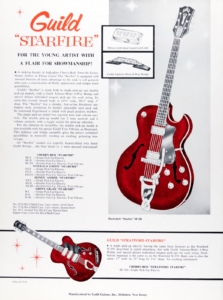 In the beginning there was the Starfire I which was a thin-line single-cut hollowbody guitar with a harp tailpiece and a single pickup in the neck position. The Starfire II was the same guitar but with two pickups, and the Starfire III was a two-pickup guitar like the Starfire II, but with a Bigsby tailpiece. This can be seen in old catalogs like this one and the one pictured which is the back page of the 1960 catalog.
In the beginning there was the Starfire I which was a thin-line single-cut hollowbody guitar with a harp tailpiece and a single pickup in the neck position. The Starfire II was the same guitar but with two pickups, and the Starfire III was a two-pickup guitar like the Starfire II, but with a Bigsby tailpiece. This can be seen in old catalogs like this one and the one pictured which is the back page of the 1960 catalog.
In the mid-1960s Guild would add more models to the Starfire line, all of which were double-cut semi-hollow guitars. The Starfire IV would be the harp-tailpiece version while the Starfire V would essentially be the Starfire IV with a Guild-emblazoned Bigsby that we in the Guild community tend to call a Guildsby.
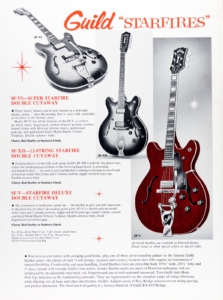 In addition to the Starfire IV and V, there was also a beautifully high-end Starfire VI Super Starfire and a Starfire XII 12-string as shown in this page from the 1966 catalog. By this time the Starfire II was called the Starfire Standard and the Starfire I seems to have gone away as evidenced by it no longer being included in the price lists such as this one from November 1966.
In addition to the Starfire IV and V, there was also a beautifully high-end Starfire VI Super Starfire and a Starfire XII 12-string as shown in this page from the 1966 catalog. By this time the Starfire II was called the Starfire Standard and the Starfire I seems to have gone away as evidenced by it no longer being included in the price lists such as this one from November 1966.
The point of all this history is to show that there were very specific designs that correspond to the models called the Starfire I, II, III, IV, V, VI, and even the XII. Those numbers mean something to the generations of Guild guitar fans who grew up lusting after and playing various permutations of these guitars. We in the Guild world and even the larger guitar world at large know what a Starfire II looks like and we know how it differs from a Starfire IV.
Guild has gone through a pile of owners since then including Avnet and US-Music. In 1995 Fender bought Guild and in 2014 they released the Newark St. line of import Guild electric guitars. We kind of rebelled a bit because for the first time model numbers like the famous S100, which was always a US-made model, were being made in Korea. This is in stark contrast to previous import guitars that went under a different brand name such as DeArmond to differentiate them from the US-made guitars. Still, for the most part the model nomenclature made sense. Then in 2014 the Cordoba Music Group bought Guild and expanded the Newark St. line with more guitars from Korea and some from China such as the Jetstar.
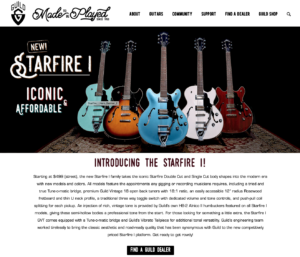 At NAMM 2020, Guild announced a new series of Newark St. Starfires called the Starfire I. Now remember, historically a Starfire I is a single cutaway hollow-body guitar with a single neck pickup, but now Starfire I isn’t a model… it’s an entire series of guitars. What’s worse, it’s an entire series of guitars that seems to contain models with all the appointments that would make them appear to be Starfire IIs, IIIs, IVs, and Vs, without calling any of them by those names. Instead of the the guitar in this new line that looks like a Starfire II being, you know, a Starfire II, it’s instead a Starfire I SC (for Single Cut). Only the guitar I’m reviewing here, which appears at first glance to be a Starfire III is also a Starfire I SC. Even more confusingly, the Starfire I SC in antique burst has a stop-tail, while the Starfire I SC in Seafoam Green like the one in this review has a Guildsby, as does the one in Snowcrest White, so apparently the differentiator for ordering one configuration over another is the finish?
At NAMM 2020, Guild announced a new series of Newark St. Starfires called the Starfire I. Now remember, historically a Starfire I is a single cutaway hollow-body guitar with a single neck pickup, but now Starfire I isn’t a model… it’s an entire series of guitars. What’s worse, it’s an entire series of guitars that seems to contain models with all the appointments that would make them appear to be Starfire IIs, IIIs, IVs, and Vs, without calling any of them by those names. Instead of the the guitar in this new line that looks like a Starfire II being, you know, a Starfire II, it’s instead a Starfire I SC (for Single Cut). Only the guitar I’m reviewing here, which appears at first glance to be a Starfire III is also a Starfire I SC. Even more confusingly, the Starfire I SC in antique burst has a stop-tail, while the Starfire I SC in Seafoam Green like the one in this review has a Guildsby, as does the one in Snowcrest White, so apparently the differentiator for ordering one configuration over another is the finish?
But wait; there’s more!
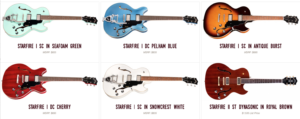 The guitar in the Starfire I series that looks like a Starfire IV carries the name of Starfire I DC (for Double Cut), but the guitar that looks like a Starfire V is called also called the Starfire I DC. The difference? The Cherry Red one has a stop-tail and the Pelham Blue one has a Guildsby. My head hurts.
The guitar in the Starfire I series that looks like a Starfire IV carries the name of Starfire I DC (for Double Cut), but the guitar that looks like a Starfire V is called also called the Starfire I DC. The difference? The Cherry Red one has a stop-tail and the Pelham Blue one has a Guildsby. My head hurts.
Here’s what I think Guild was trying to do: They’ve released a new low-cost line of guitars (these being made in Indonesia) with the same or similar form factors to the iconic models I covered above, but they wanted to somehow differentiate them all from the higher-priced models with the traditional nomenclature. I can appreciate that, but based on the conversations I’ve read online, people are massively confused and largely don’t understand. The good news is that people can walk into a guitar store (which seems like a far away dream here in the 2020 Coronavirus lockdown) or visit their favorite online guitar seller, point to the one they like and push the button. Regardless of what they’re named, I like that one and I can afford it is not a bad way to sell guitars (or anything else for that matter).
I think Guild painted themselves into a corner a bit by not just introducing a new name for this line. Something along the lines of Gretsch vs. Electromatic, or Fender vs. Squire would seem to make sense to me, but honestly I think that’s what they should have done with the Newark St. guitars in the first place so I think that ship has sailed. People respond to the Guild logo and I get wanting to keep that; I just think they would have been better served calling the guitar in this review something like the Starfire III SE and the blue one the Starfire V SE, and so-on. It would have kept the naming convention that people have known forever and still made it clear that these were something new.
However…
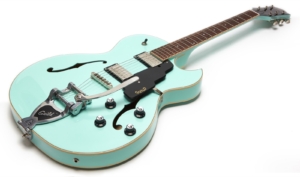 In Guild’s defense, these guitars are built differently than either the II, III, IV or V (see the Build Quality section for detail). This one is not hollow, and it doesn’t have a center block running down the middle, either, so I could easily argue that it shouldn’t have the traditional Starfire III identifier. But these are quite clearly Starfires, and they’re quite clearly derived from those iconic models, so what could Guild do? Well, the currently listed Starfire II ST is not built like a traditional II, either, and that still gets the II in the name (a matter that also offended some of the Guild cognoscenti, myself included if I’m being honest.) I think they named that one a bit better, though, because it still looks like a II, but the ST in the name shows that it’s different. Even though the ST just stands for Stop Tail, the fact that the guitar has a stop tail means that it’s built differently because you can’t have a stop tail on a hollow body guitar. Unlike that Starfire II ST, the Starfire Is are also made to fit a lower price point, so that’s one more reason for their own classification. In fact, it’s probably the only reason.
In Guild’s defense, these guitars are built differently than either the II, III, IV or V (see the Build Quality section for detail). This one is not hollow, and it doesn’t have a center block running down the middle, either, so I could easily argue that it shouldn’t have the traditional Starfire III identifier. But these are quite clearly Starfires, and they’re quite clearly derived from those iconic models, so what could Guild do? Well, the currently listed Starfire II ST is not built like a traditional II, either, and that still gets the II in the name (a matter that also offended some of the Guild cognoscenti, myself included if I’m being honest.) I think they named that one a bit better, though, because it still looks like a II, but the ST in the name shows that it’s different. Even though the ST just stands for Stop Tail, the fact that the guitar has a stop tail means that it’s built differently because you can’t have a stop tail on a hollow body guitar. Unlike that Starfire II ST, the Starfire Is are also made to fit a lower price point, so that’s one more reason for their own classification. In fact, it’s probably the only reason.
I think maybe if they’d forgone the roman numerals altogether for this line and called it something like the Starfire X, then it would have made more sense. X is a variable – it can mean whatever you need it to mean, and I think a Starfire X SC sounds pretty badass, it doesn’t conflict with a 55-year-old standard naming scheme, and it’s clearly something new. Sure, X is another Roman numeral, but at least it’s one that’s not been used to identify Starfires before.
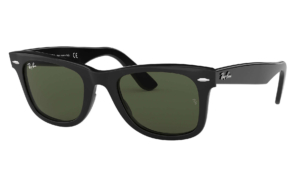 All of this could have been solved from the beginning by not calling them Guilds, but then Cordoba would’t be able to capitalize on selling import merchandise with a recognized brand name that’s synonymous with US-made quality. As much as I hate that, I can’t blame Cordoba as this this has been a trend in the US for 30 years. Just look at brand names like General Electric, Zenith, Gillette, Levis, Fisher Price, Schwinn, Rawlings, Radio Flyer, Craftsman, Ray Ban sunglasses, and even the American Girl Dolls.
All of this could have been solved from the beginning by not calling them Guilds, but then Cordoba would’t be able to capitalize on selling import merchandise with a recognized brand name that’s synonymous with US-made quality. As much as I hate that, I can’t blame Cordoba as this this has been a trend in the US for 30 years. Just look at brand names like General Electric, Zenith, Gillette, Levis, Fisher Price, Schwinn, Rawlings, Radio Flyer, Craftsman, Ray Ban sunglasses, and even the American Girl Dolls.
Back to the guitar, the first way they’re making these so inexpensive is by making them in Indonesia.
The case
 Here’s the second way guild can sell these for such a low price: they do not ship with a case. At the current selling price of a Guild Starfire case that’s a $150 add-on, so that’s a pretty big difference when you consider a street price of $599 vs. $749. You will need a case or a really robust gig bag, but psychologically the lower price is a bargain.
Here’s the second way guild can sell these for such a low price: they do not ship with a case. At the current selling price of a Guild Starfire case that’s a $150 add-on, so that’s a pretty big difference when you consider a street price of $599 vs. $749. You will need a case or a really robust gig bag, but psychologically the lower price is a bargain.
This picture is how the guitar was shipped from the factory, and I must say it was very secure and suffered no damage in transit. It’s probably not the preferred way to transport the guitar to a gig, but if you buy one new from a dealer online I wouldn’t worry to much about that first trip. If you buy one used, make sure to ask if there’s a case or if it comes in the original packaging.
If you have a Starfire I and want a Guild case, then this is the case to buy (just make sure that you choose the Starfire option.) Of course when I went to buy one they were out of stock, so I went elsewhere only to discover that no one has them in stock. Hmmm… I bet theyr’e sold out because everyone who bought a Starfire I had to go buy a damn case. At any rate now I’ll end up storing mine in a Westerly Starfire case that’s probably worth as much as the guitar.
Finish
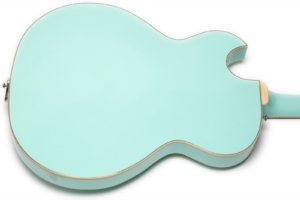 First off, let me just say that I love love LOVE the color! My eldest daughter who does not play guitar said that when she has a house of her own that she’ll buy one just to hang on the wall because that’s how pretty it is.
First off, let me just say that I love love LOVE the color! My eldest daughter who does not play guitar said that when she has a house of her own that she’ll buy one just to hang on the wall because that’s how pretty it is.
A guitar that’s offered in mostly solid colors mean that the wood choice doesn’t have to be anything special, at least visually. These guitars are all laminate just like the other Starfire models, but with a solid finish they can use wood that doesn’t look as good which is generally less expensive than the pretty stuff.
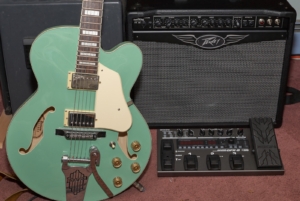 Back in 2005 (15 years ago as of this writing) I had realized how stupid it was of me to sell my coveted S300AD and walked into a guitar store where I saw this turquoise Ibanez Artcore AFS75TD hanging on the wall. If memory serves the guitar had a list price of $499.99 and I paid something like $350 for it, a price I found to be incredible at the time. I bought an inexpensive tube amp and multi-effects pedal, and that setup would be my only guitar until 2008 when I bought a Jackson, then a Guild Starfire after which I set out to buy all the Guilds and now here we are.
Back in 2005 (15 years ago as of this writing) I had realized how stupid it was of me to sell my coveted S300AD and walked into a guitar store where I saw this turquoise Ibanez Artcore AFS75TD hanging on the wall. If memory serves the guitar had a list price of $499.99 and I paid something like $350 for it, a price I found to be incredible at the time. I bought an inexpensive tube amp and multi-effects pedal, and that setup would be my only guitar until 2008 when I bought a Jackson, then a Guild Starfire after which I set out to buy all the Guilds and now here we are.
Anyway, I loved that green Ibanez and when Guild came out with this Seafoam Green Starfire I SC, I simply had to have it because just look at it! It’s a damn pretty guitar.
Fretboard and Neck
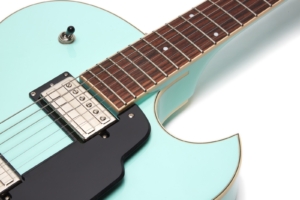 The scale length of the Starfire I SC is 24 3/4″. The neck is listed as Modern Thin U shaped but I wouldn’t call it thin, really. It may be thin in comparison to a huge Gibson R8 neck, but with this guitar measuring .83″ deep at the first fret, I’d call this a wonderfully comfortable medium, especially because if the neck maintained its contour as a C-shape instead of a U, I think it would be close to .9″ deep at the nut. The neck stays remarkably consistent until it gets up to the neck heal where measurements don’t matter any more.
The scale length of the Starfire I SC is 24 3/4″. The neck is listed as Modern Thin U shaped but I wouldn’t call it thin, really. It may be thin in comparison to a huge Gibson R8 neck, but with this guitar measuring .83″ deep at the first fret, I’d call this a wonderfully comfortable medium, especially because if the neck maintained its contour as a C-shape instead of a U, I think it would be close to .9″ deep at the nut. The neck stays remarkably consistent until it gets up to the neck heal where measurements don’t matter any more.
The fretboard radius is listed at 12.5″ (20mm). Note that this is a departure from the similarly shaped Starfire III which is 9.5″. It may well be 12.5″ but I only have guages that measure 10, 12, 14, etc., so I listed it as 12″ in my notes. The fret size is listed as narrow tall vs. narrow jumbo on the Newark St. SFIII, and the frets on my Starfire I SC measure .05″ high by .095″ wide. The nut on this guitar is composite while the Starfire III’s is bone, so there’s another cost saving that I would fully expect on a guitar at this price point.
The frets are finished really well on my sample and I feel no sharp or raised ends. That’s honestly amazing to me because when I was a kid, one of the hallmarks of a cheap guitar was the crappy frets. What a world we live in where inexpensive guitars don’t have to suck!
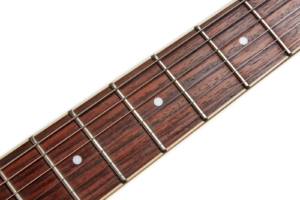 The neck is maple and the fretboard is bound Indian rosewood which honestly looks fabulous. This guitar is a factory second and I got it for a great price because there is red dot on the fretboard. A dot that I have to look for every time because it’s practically unnoticeable. Do you see it in the pic of the fretboard? Zoom in if you don’t. It appears to be a flaw in the wood, though I can’t imagine why such a flaw would be red like that, but I have to say that I’m kind of impressed that the Quality Assurance team would fail a $600 guitar for such a thing.
The neck is maple and the fretboard is bound Indian rosewood which honestly looks fabulous. This guitar is a factory second and I got it for a great price because there is red dot on the fretboard. A dot that I have to look for every time because it’s practically unnoticeable. Do you see it in the pic of the fretboard? Zoom in if you don’t. It appears to be a flaw in the wood, though I can’t imagine why such a flaw would be red like that, but I have to say that I’m kind of impressed that the Quality Assurance team would fail a $600 guitar for such a thing.
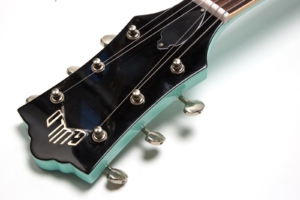 There is no fancy inlay on the headstock aside from the Guild logo, which I thought would be something like paint, but it’s actually got a very cool raised look to it. Whatever it is, I like it a lot, and I think the plain black face with the golden logo looks pretty great. While I love a traditional guitar, I think this is a elegantly classy yet simple design that works well. I don’t know if that black face is just finish, paint, or what, but it’s very well done. The logo, if it is actually raised, is contained within the finish so the face feels perfectly smooth. My guess is that this is some sort of raised sticker that’s finished onto the headstock, but honestly I just don’t care because it does not look cheap. Good job to however designed that!
There is no fancy inlay on the headstock aside from the Guild logo, which I thought would be something like paint, but it’s actually got a very cool raised look to it. Whatever it is, I like it a lot, and I think the plain black face with the golden logo looks pretty great. While I love a traditional guitar, I think this is a elegantly classy yet simple design that works well. I don’t know if that black face is just finish, paint, or what, but it’s very well done. The logo, if it is actually raised, is contained within the finish so the face feels perfectly smooth. My guess is that this is some sort of raised sticker that’s finished onto the headstock, but honestly I just don’t care because it does not look cheap. Good job to however designed that!
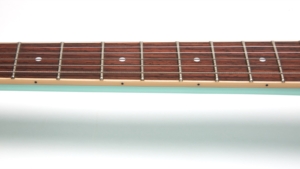 The inlays are listed as 5mm pearloid dots where the SFIII spec sheet just says pearloid dots — are these smaller than the Stafire III’s? I no longer have that guitar, but in looking at the pictures they seem about the same. I do notice far more character in the Starfire III’s dots, though, as if those are more pearloid and these are more plain, if that makes sense. I can’t see how it matters on such small inlays, so I consider that a wash.
The inlays are listed as 5mm pearloid dots where the SFIII spec sheet just says pearloid dots — are these smaller than the Stafire III’s? I no longer have that guitar, but in looking at the pictures they seem about the same. I do notice far more character in the Starfire III’s dots, though, as if those are more pearloid and these are more plain, if that makes sense. I can’t see how it matters on such small inlays, so I consider that a wash.
Build Quality
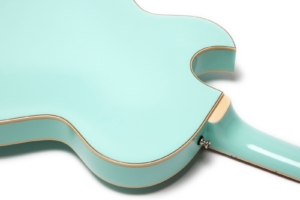 This is an inexpensive guitar, but it does not feel at all like a cheap guitar. In fact, it feels more solid than my similarly shaped and far more expensive Stafire IIIs! Why? Because of the way it’s made. Remember, this is not a hollowbody guitar; this is a semi-hollowbody guitar. That’s not to say that it’s built like a Starfire IV, because it’s not. This guitar is its own thing which is likely one of the reasons why it and its brethren got their own series identifier.
This is an inexpensive guitar, but it does not feel at all like a cheap guitar. In fact, it feels more solid than my similarly shaped and far more expensive Stafire IIIs! Why? Because of the way it’s made. Remember, this is not a hollowbody guitar; this is a semi-hollowbody guitar. That’s not to say that it’s built like a Starfire IV, because it’s not. This guitar is its own thing which is likely one of the reasons why it and its brethren got their own series identifier.
Let’s take a look inside.
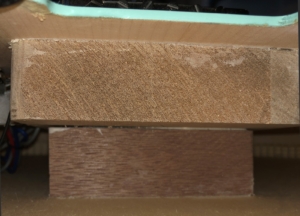 Internally the guitar is hollow with what I might describe as the mother of all sound blocks. There is a roughly three inch square (or appears to be square – I couldn’t prove that) mahogany block on the bottom of the guitar which has a roughly 4-5″ block of what looks like maple sitting on top of it that contacts the top. The maple block is what the bridge bushings are pressed into and what the Guildsby is screwed into. This block does not contact the bottom of the guitar (where the end pin is), nor does it go anywhere near the pickups as would be the case with a traditional semi-hollow guitar.
Internally the guitar is hollow with what I might describe as the mother of all sound blocks. There is a roughly three inch square (or appears to be square – I couldn’t prove that) mahogany block on the bottom of the guitar which has a roughly 4-5″ block of what looks like maple sitting on top of it that contacts the top. The maple block is what the bridge bushings are pressed into and what the Guildsby is screwed into. This block does not contact the bottom of the guitar (where the end pin is), nor does it go anywhere near the pickups as would be the case with a traditional semi-hollow guitar.
Additionally, there are no longitudinal top braces of the kind you would see in a Starfire III or similar hollowbody guitar, likely because the giant blocks make them unnecessary. This pic shows the back end of the sound block with the tail block that holds the end pin in the distance. You can see that there are no braces on the guitar’s top. This design change is noticeable when playing and I’ll talk more about that down in the Sound and Playability sections.
I imagine this is a large cost-savings in the manufacturing process because there’s less skill needed when jamming two blocks of wood between the front and back than there is in properly laying out and gluing to bracing. Yes, there is a difference in tone and feel, but this is a $600 guitar, remember.
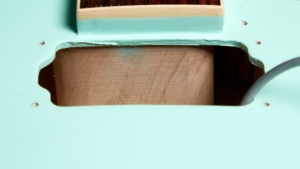 The neck joint seems pretty standard at first glance, but I noticed that the end of the fretboard is connected to the top which is not the case on most semihollow or hollow-body guitars including every Starfire III I’ve owned. Even on my Newark St. Starfire III, you can see that the end of the fretboard lifts up and away from the guitar’s top. My guess is that on a hollow-body guitar the fretboard slopes away from the top to aid in the top being more resonant but I’m happy to be proven wrong. I’m not sure if this is another cost-saving measure, so if you’ve got luthier experience and have an answer please leave a comment.
The neck joint seems pretty standard at first glance, but I noticed that the end of the fretboard is connected to the top which is not the case on most semihollow or hollow-body guitars including every Starfire III I’ve owned. Even on my Newark St. Starfire III, you can see that the end of the fretboard lifts up and away from the guitar’s top. My guess is that on a hollow-body guitar the fretboard slopes away from the top to aid in the top being more resonant but I’m happy to be proven wrong. I’m not sure if this is another cost-saving measure, so if you’ve got luthier experience and have an answer please leave a comment.
Inside the guitar’s bass-side f-hole is the sticker which is an homage to the original “ghost label” stickers used back in Guild’s Hoboken days. Since both the model and serial numbers look like some sort of code from the days of computer punch cards, I thought I’d break each of them down for posterity:
Model Number
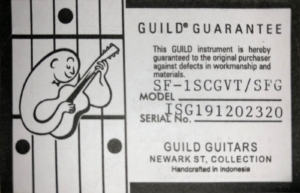 SF-ISCGVT/SFG – Starfire I
SF-ISCGVT/SFG – Starfire I- SF-ISCGVT/SFG – Single Cut
- SF-ISCGVT/SFG – Guild Vibrato Tailpiece
- SF-ISCGVT/SFG – Seafoam Green
Serial Number
- ISG191202320 – Samick, Bogor Indonesia
- ISG191202320 – Guild
- ISG191202320 – 2019, December
- ISG191202320 – 5 digit sequence
A very special thanks to Ralf over on the LetsTalkGuild forum for breaking the serial number format down in this post. The big takeaway here is that this guitar is made in Indonesia at the Samick plant.
This guitar weighs almost exactly seven pounds (3.18 kg) which is largely due to those big sound blocks, but interestingly this guitar weighs almost exactly the same as my 1997 Starfire III which is fully hollow.
As a last note, this guitar has a thicker body than the Newark St. Stafire III which is patterned off of the ’60s Starfires. The Starfire I SC has a body depth that makes it feel more like the ’90s Starfire reissues, so bear that in mind if you’re looking at this guitar, because it has a different feel than the Newark St. Starfire III. Honestly, I like the thicker bodies like this one better, but that’s very much a personal preference.
Pickups
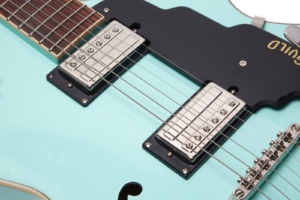 All of the Starfire I guitars come with the new Guild HB2 pickups which are supposedly inspired by the HB1s. I’m not sure how much inspiration there really was aside from the covers, but I’ll let you judge for yourself in the sound section. I’ll know more about the technical details when I tear open the extra one I bought in order to take pictures like I did for the HB1s and AntiHums.
All of the Starfire I guitars come with the new Guild HB2 pickups which are supposedly inspired by the HB1s. I’m not sure how much inspiration there really was aside from the covers, but I’ll let you judge for yourself in the sound section. I’ll know more about the technical details when I tear open the extra one I bought in order to take pictures like I did for the HB1s and AntiHums.
What’s very cool about these pickups, though, is that they’re both four-wire which means some interesting things can be done with them as we’ll see in the electronics section below.
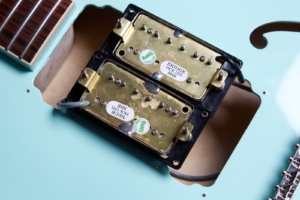 From the factory these pickups have RoHS compliancy sticker and a BRIDGE PICK UPS BHK sticker with BHK being the abbreviation for BooHeung Precision Machinery in Korea where the pickups are made. The pickups are stamped with a BH logo and the letters F and R which mean Front (neck) and Rear (bridge). My pickups measure 7.17k (neck) and 7.43k (bridge) which is in the range of vintage HB1s, but these pickups in this guitar don’t sound quite as wonderful as my favorite HB1 pickups. That may have something to do with the electronics, but I don’t think so. More on that in the next couple of sections.
From the factory these pickups have RoHS compliancy sticker and a BRIDGE PICK UPS BHK sticker with BHK being the abbreviation for BooHeung Precision Machinery in Korea where the pickups are made. The pickups are stamped with a BH logo and the letters F and R which mean Front (neck) and Rear (bridge). My pickups measure 7.17k (neck) and 7.43k (bridge) which is in the range of vintage HB1s, but these pickups in this guitar don’t sound quite as wonderful as my favorite HB1 pickups. That may have something to do with the electronics, but I don’t think so. More on that in the next couple of sections.
BHK makes the Newark St. HB1 pickups, the Newark St. LB1 pickups, and now these HB2s. BHK also makes about 1000 other models for other import guitars from just about every major brand out there, and none of the ones I’ve seen are ever labeled in any way aside from what you see on these two HB2s. At least with these the iconic Guild double-hump covers offer a clue as to what they are.
Electronics
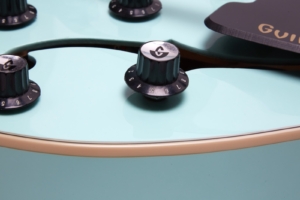 The biggest feature of the electronics on this and all other Starfire I guitars is the fact that you can split the pickup coils on each pickup individually via push/pull pots in the volume positions. That means that the following combinations are possible:
The biggest feature of the electronics on this and all other Starfire I guitars is the fact that you can split the pickup coils on each pickup individually via push/pull pots in the volume positions. That means that the following combinations are possible:
- Neck (humbucker)
- Neck (single coil)
- Both (hum/hum)
- Both (hum/single)
- Both (single/hum)
- Both (single/single)
- Bridge (humbucker)
- Bridge (single coil)
That’s eight choices! The Newark St. Starfire III has no coil split capability so it only has the traditional three positions, making this guitar arguably more versatile than its more expensive cousin.
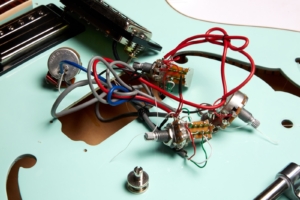 I didn’t feel like pulling the harness because it can be a royal pain on guitars like this, but I sucked it up, set aside a couple of hours and pulled it out in the name of science. I’m glad I did because the quality of the electronics wiring is… not good. Also, I needed more than a couple of hours because holy CRAP look at those wires!
I didn’t feel like pulling the harness because it can be a royal pain on guitars like this, but I sucked it up, set aside a couple of hours and pulled it out in the name of science. I’m glad I did because the quality of the electronics wiring is… not good. Also, I needed more than a couple of hours because holy CRAP look at those wires!
Now, I’m willing to let a fair bit of my obsessive wiring tendencies go when looking at import guitars, especially since they usually cost significantly less than most domestic guitars, but there’s a limit, and that limit is a guitar that barely works right.
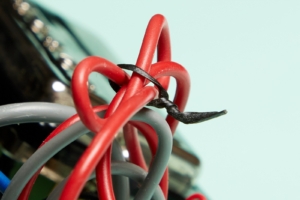 On the Korean Newark St. guitars I’ve examined like the Newark St. Starfire III, the wiring is logical, well soldered, and pretty clean. It looks like someone found the right way to route the wires, made it a standard, and went so far as to insulate the bare wires with heat-shrink tubing. On this guitar, the wiring is a tangled mess literally tied together with twist ties with no regard for elegance or cleanliness. If you worked for me and wired this I’d make you work in the repair department until you understood the benefit of clean wiring. This wiring looks like it was done by nine-year-olds who have never had to repair anything. It’s bad. It’s really bad.
On the Korean Newark St. guitars I’ve examined like the Newark St. Starfire III, the wiring is logical, well soldered, and pretty clean. It looks like someone found the right way to route the wires, made it a standard, and went so far as to insulate the bare wires with heat-shrink tubing. On this guitar, the wiring is a tangled mess literally tied together with twist ties with no regard for elegance or cleanliness. If you worked for me and wired this I’d make you work in the repair department until you understood the benefit of clean wiring. This wiring looks like it was done by nine-year-olds who have never had to repair anything. It’s bad. It’s really bad.
But wait; there’s more.
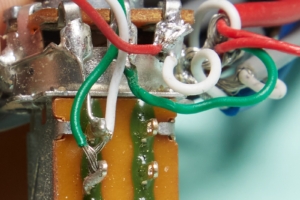 On one of my push/pull pots the hot lead was shorted to ground. On the same connection, the wires were soldered to the connector and not through it. Why does that matter? Because doing it the wrong way means that failures are more likely in the future. A properly soldered connection should last just shy of forever. These will not. Honestly I’m surprised that some of these connections lasted until they got to my house. This amateurish soldering technique was repeated in multiple spots all over the harness. There are what appear to be cold solder joints, poor solder joints, and wires that appear to have been laid on existing solder blobs then sort of melted in as opposed to properly wiring them to the connectors. There were stray strands of wire sticking out and rubbing against other connectors. Where there are stranded wires, they have been soldered without twisting or tinning the ends. Honestly I wanted to gut the entire thing but I didn’t because I wanted to test the guitar as delivered.
On one of my push/pull pots the hot lead was shorted to ground. On the same connection, the wires were soldered to the connector and not through it. Why does that matter? Because doing it the wrong way means that failures are more likely in the future. A properly soldered connection should last just shy of forever. These will not. Honestly I’m surprised that some of these connections lasted until they got to my house. This amateurish soldering technique was repeated in multiple spots all over the harness. There are what appear to be cold solder joints, poor solder joints, and wires that appear to have been laid on existing solder blobs then sort of melted in as opposed to properly wiring them to the connectors. There were stray strands of wire sticking out and rubbing against other connectors. Where there are stranded wires, they have been soldered without twisting or tinning the ends. Honestly I wanted to gut the entire thing but I didn’t because I wanted to test the guitar as delivered.
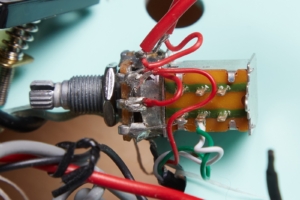 The tone pots are marked Made in Korea by Jin Sung and appear to be the same pots used on other Newark St. guitars such as the Bluesbird I reviewed here. The volume pots are smaller pots like you would find in a pedal, and also have the push-pull switch attached to them in order to allow each pickup to be individually coil-splt (a cool feature, in my opinion). These pots are not marked with manufacturer’s codes that I could see. The volumes are both A500 log scale audio taper pots and the tones are both B500 linear scale pots, and that is not a typo. I’m not sure why the volume pots are the push pulls instead of the tone pots, and I’d think if you’re a fan of volume swells that you’d likely get annoyed by accidentally pushing in the knob while performing that technique in single-coil mode.
The tone pots are marked Made in Korea by Jin Sung and appear to be the same pots used on other Newark St. guitars such as the Bluesbird I reviewed here. The volume pots are smaller pots like you would find in a pedal, and also have the push-pull switch attached to them in order to allow each pickup to be individually coil-splt (a cool feature, in my opinion). These pots are not marked with manufacturer’s codes that I could see. The volumes are both A500 log scale audio taper pots and the tones are both B500 linear scale pots, and that is not a typo. I’m not sure why the volume pots are the push pulls instead of the tone pots, and I’d think if you’re a fan of volume swells that you’d likely get annoyed by accidentally pushing in the knob while performing that technique in single-coil mode.
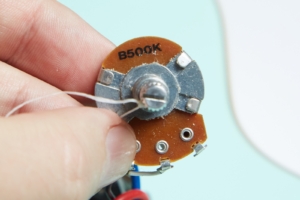 BTW I find the tone pots being linear to be a problem, and by problem I mean useless. The tone knobs behave like an on/off switch where there is no appreciable change between about 9-2 (these knobs are numbered 1-9, remember) and when you go from 2 to 1 it’s like throwing a big wet blanket over the amp. It’s almost like someone got the installation backwards because it would make a lot more sense to me to have the linear pots on the volume and the push/pull audio taper pots on the tones. Hmm. Now I’m wondering if someone screwed up when building all the harnesses and they just kept it that way.
BTW I find the tone pots being linear to be a problem, and by problem I mean useless. The tone knobs behave like an on/off switch where there is no appreciable change between about 9-2 (these knobs are numbered 1-9, remember) and when you go from 2 to 1 it’s like throwing a big wet blanket over the amp. It’s almost like someone got the installation backwards because it would make a lot more sense to me to have the linear pots on the volume and the push/pull audio taper pots on the tones. Hmm. Now I’m wondering if someone screwed up when building all the harnesses and they just kept it that way.
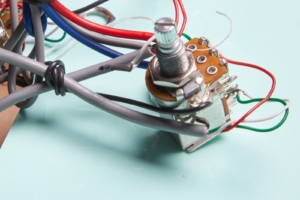 Oh – and as if all of that stuff wasn’t enough to get your clean wiring knickers in a twist, the ground wire that goes to the bridge is also used as a sort of wire tie to, I don’t know… clean up?… the cables to the bridge pickup and the toggle switch. I would be tempted to say something like, “I have no words.”, but clearly that’s not an issue for me. I’ve got words and I’m not afraid to use them, and that’s why I don’t have sponsors or ads.
Oh – and as if all of that stuff wasn’t enough to get your clean wiring knickers in a twist, the ground wire that goes to the bridge is also used as a sort of wire tie to, I don’t know… clean up?… the cables to the bridge pickup and the toggle switch. I would be tempted to say something like, “I have no words.”, but clearly that’s not an issue for me. I’ve got words and I’m not afraid to use them, and that’s why I don’t have sponsors or ads.
I did not pull the toggle switch but I have to imagine it’s of the same ilk as the other electronic components, and will likely need to be replaced after a year or so of use since in my experience cheap toggles don’t last.
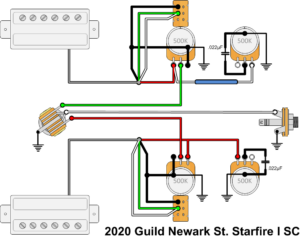 Looking at this wiring I’d say they saved money by hiring people off the street who didn’t know anything about wiring or soldering, gave them a 1£ soldering iron from Malaysia and paid them by the guitar. If I were to consider gigging with this guitar, and I should point out that aside from the electronics this is a very playable guitar, then I would likely end up gutting the electronics entirely and rewiring by hand.
Looking at this wiring I’d say they saved money by hiring people off the street who didn’t know anything about wiring or soldering, gave them a 1£ soldering iron from Malaysia and paid them by the guitar. If I were to consider gigging with this guitar, and I should point out that aside from the electronics this is a very playable guitar, then I would likely end up gutting the electronics entirely and rewiring by hand.
For what it’s worth, I imagine that this schematic would be the same for every Starfire I guitar model since having one harness for all of them would be one more way to lower costs across the line.
Hardware
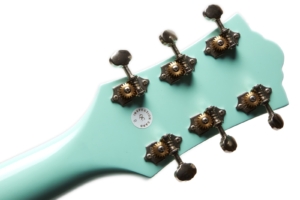 The tuners are listed as Guild Vintage 18 Open Gear Tuners on the spec sheet. This is different than the Starfire III, IV, and V Newark St. guitars that list Grover® Sta-Tite™ Open-Gear 18:1 tuners, and while these look very similar, they don’t say Grover on them so I have to imagine that they’re either a) cheap knock-offs or b) unbranded OEM. I’ve never been a fan of open-gear tuners, but these have held tune well enough for the couple of weeks I’ve owned the guitar. I dislike the vintage style buttons, but I’ve griped about that in every Newark St. guitar review and it’s definitely a personal preference kind of thing so your mileage may vary. If I were to gig with the guitar they’d be gone, replaced with locking tuners that make stringing a Bigsby easier.
The tuners are listed as Guild Vintage 18 Open Gear Tuners on the spec sheet. This is different than the Starfire III, IV, and V Newark St. guitars that list Grover® Sta-Tite™ Open-Gear 18:1 tuners, and while these look very similar, they don’t say Grover on them so I have to imagine that they’re either a) cheap knock-offs or b) unbranded OEM. I’ve never been a fan of open-gear tuners, but these have held tune well enough for the couple of weeks I’ve owned the guitar. I dislike the vintage style buttons, but I’ve griped about that in every Newark St. guitar review and it’s definitely a personal preference kind of thing so your mileage may vary. If I were to gig with the guitar they’d be gone, replaced with locking tuners that make stringing a Bigsby easier.
The knobs are Newark St. remakes of the old Volume/Tone labeled 1-9 knobs from the Hoboken days. They look great and are very much a Guild tradition.
The strap pegs are listed as Vintage Pawn vs Vintage Style on the Newark St. Starfire III. I have no idea what Vintage Pawn means and honestly, I don’t care enough to figure it out. There’s only so many levels of crazy I’m willing to go and I already pulled the damn wiring. After that I just need a drink.
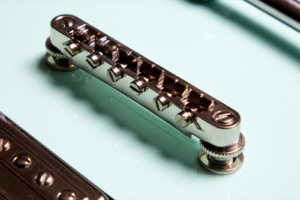 The bridge is a Guild Tune-O-Matic that has bushing pressed right through the top and into that big block inside. This is a big difference to the Starfire III because that guitar is fully hollow and thus has a floating bridge where this same part sits on top of a wooden base that then sits on the top of the guitar. The bridge is listed as having a 9.5″ radius while the guitar’s fretboard is 12″ (or 12.5″ if the specs are correct) which could theoretically lead to problems for the more sensitive-fingered, most especially on the higher frets where the center strings will be higher from the fretboard than the outer strings. Gretsch Setzer guitars have a similar problem though in reverse (12″ bridge with a 9.5″ fretboard). On the Gretsches I believe this is an effort to simulate what’s on Brian’s own guitar, but on the Guild I have to think that it’s just a matter of using off-the-shelf parts to lower costs. Honestly, I don’t notice the difference 99% of the time and when I do notice it my brain says, Dude, this is a $600 guitar that you got for $450 because of a red dot on the fretboard. Maybe take a break and go outside for a while.
The bridge is a Guild Tune-O-Matic that has bushing pressed right through the top and into that big block inside. This is a big difference to the Starfire III because that guitar is fully hollow and thus has a floating bridge where this same part sits on top of a wooden base that then sits on the top of the guitar. The bridge is listed as having a 9.5″ radius while the guitar’s fretboard is 12″ (or 12.5″ if the specs are correct) which could theoretically lead to problems for the more sensitive-fingered, most especially on the higher frets where the center strings will be higher from the fretboard than the outer strings. Gretsch Setzer guitars have a similar problem though in reverse (12″ bridge with a 9.5″ fretboard). On the Gretsches I believe this is an effort to simulate what’s on Brian’s own guitar, but on the Guild I have to think that it’s just a matter of using off-the-shelf parts to lower costs. Honestly, I don’t notice the difference 99% of the time and when I do notice it my brain says, Dude, this is a $600 guitar that you got for $450 because of a red dot on the fretboard. Maybe take a break and go outside for a while.
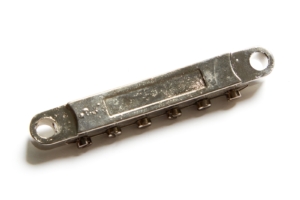 The bridge looks like a low-cost pot-metal generic part compared to the older Gotoh bridges seen on the ’90s US-made Guilds, but that’s kind of to be expected on a guitar that was designed and built to exist at the price point where this model lives (says my brain because I clearly haven’t yet gone outside).
The bridge looks like a low-cost pot-metal generic part compared to the older Gotoh bridges seen on the ’90s US-made Guilds, but that’s kind of to be expected on a guitar that was designed and built to exist at the price point where this model lives (says my brain because I clearly haven’t yet gone outside).
My neurosis about quality parts aside, my only real gripe with the bridge is that it has a retaining wire and I tend to really dislike those because they always seem to end up buzzing. A drop of clear nail polish is the fix for that, but I just don’t see why we’re still using a flawed design from 70 years ago. Well, that and the fact that a guitar with a Bigsby should have a roller or rocking bridge.
The tailpiece is listed in the spec sheet as Guild Vibrato Tailpiece Semi Hollow – Aluminum and is responsible for the GVT part of the model number. That was not obvious to me at first and I had to dig a bit to see what the hell a GVT was, so let me spare you the angst: If you see other Guilds listed as including a GVT, they’re talking about a Guildsby. I’m not sure GVT is the sexiest of names, especially when the delicious portmanteau Guildsby already exists in the public consciousness but again, I’m not fit to work in Marketing what with my incessant need for words to be used the right way and all.
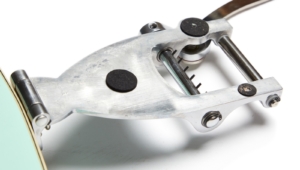 That GVT (ooh… so sexy…) seems to be well made, and so far I have no complaints. Whether it will stand up to years of abuse while I try to remember that it’s not a Floyd Rose and thus should not be used for dive bombs is anyone’s guess, but when playing Bigsby-appropriate songs it seems to behave as it should with no obvious noises, rattles, or other distractions. Sure, it doesn’t have quite the luxurious feel of a fifty-year-old well worn example, but this is a $600 guitar that behaves better than the price tag would have you believe.
That GVT (ooh… so sexy…) seems to be well made, and so far I have no complaints. Whether it will stand up to years of abuse while I try to remember that it’s not a Floyd Rose and thus should not be used for dive bombs is anyone’s guess, but when playing Bigsby-appropriate songs it seems to behave as it should with no obvious noises, rattles, or other distractions. Sure, it doesn’t have quite the luxurious feel of a fifty-year-old well worn example, but this is a $600 guitar that behaves better than the price tag would have you believe.
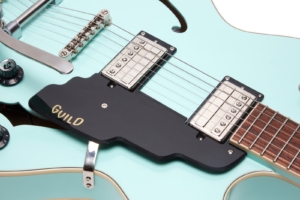 I will say that the pick guard drives me nuts even though I love the look. First, it was kind of loose and thumped every time I touched it which drove me crazier than a kid trying to memorize a thesaurus (I totally never did that). After removing it for my detailed inspection I discovered that instead of the normal felt washer you’d find under a hollow-body pick guard, this guitar had a small plastic spacer underneath that looked like a piece of hard plastic tubing. Also, the pick guard sits on top of the pickup rings which I’ve always found to be a terrible design. I mean, they fixed this in the ’90s, so why bring it back? Historical accuracy? On a guitar that’s not quite like anything they ever made before? Dumb.
I will say that the pick guard drives me nuts even though I love the look. First, it was kind of loose and thumped every time I touched it which drove me crazier than a kid trying to memorize a thesaurus (I totally never did that). After removing it for my detailed inspection I discovered that instead of the normal felt washer you’d find under a hollow-body pick guard, this guitar had a small plastic spacer underneath that looked like a piece of hard plastic tubing. Also, the pick guard sits on top of the pickup rings which I’ve always found to be a terrible design. I mean, they fixed this in the ’90s, so why bring it back? Historical accuracy? On a guitar that’s not quite like anything they ever made before? Dumb.
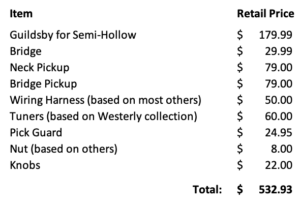 As I was looking in on the Guild parts website to see if I could just buy a wiring harness to examine instead of tearing this one apart, I saw that the Guild Bigsby (Guildsby) for this guitar sells for $179.99 which is almost half what I paid for the entire guitar. That made me wonder what the total price of all the parts might be so I went and looked them all up and compiled this list. These prices reflect what I saw in May of 2020, and they are retail prices, but it just goes to show that if you bought the parts yourself you would have about $70 left for the wooden parts of the guitar.
As I was looking in on the Guild parts website to see if I could just buy a wiring harness to examine instead of tearing this one apart, I saw that the Guild Bigsby (Guildsby) for this guitar sells for $179.99 which is almost half what I paid for the entire guitar. That made me wonder what the total price of all the parts might be so I went and looked them all up and compiled this list. These prices reflect what I saw in May of 2020, and they are retail prices, but it just goes to show that if you bought the parts yourself you would have about $70 left for the wooden parts of the guitar.
Sound
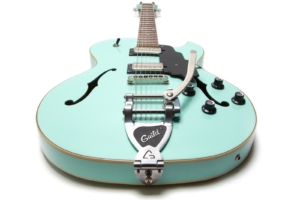 Here’s where the rubber meets the road. Sure the wiring is ugly, but the guitar is damn pretty. How does it sound, though? That’s what matters most.
Here’s where the rubber meets the road. Sure the wiring is ugly, but the guitar is damn pretty. How does it sound, though? That’s what matters most.
Unplugged, this guitar is a lot of fun and pretty loud acoustically. It’s not as vibrant or “alive” as a vintage Starfire by any stretch, but unless you’ve got experience with one of those you’d never know the difference. The main reason for that is probably the giant block of wood connecting the top and back, but this guitar was billed as a semi-hollow, so complaining about that would be dumb.
[dropshadowbox align=”right” effect=”raised” width=”” height=”” background_color=”#ffffff” border_width=”1″ border_color=”#dddddd” ]ODS100 Humbucker
Open Chords #1
Open Chords #2
D-Shape
7th Chords
JCM-800 Humbucker
D-Shape
A-Shape
[/dropshadowbox]As usual, for these recordings I used my normal Axe-FX III through the QSC K12 speaker recorded direct into my Mac Pro using Audacity. I recorded using the ODS100 Clean patch, as well as the JCM-800. I recorded my normal samples with one full set on humbucker mode and one on single coil. For each recording I cycle through the neck pickup, both pickups, and finally the bridge pickup. All knobs on the guitar are on 10 at all times.
When I first got this guitar I plugged it in and went to town and the guitar sounded… not great. Both pickups were very muddy on humbucker mode but sounded much better in single coil mode, though the bridge push/pull didn’t seem to have any effect.
Then I fixed the wiring.
With the pickups in humbucker mode with all of the knobs on ten things can get to be a bit much. That may be fixable by lowering the pickups or adjusting the amp, but I try to keep everything the same when doing these reviews. I did notice the guitar having a tendency to get a bit woofy and fizzy, but in a way that only a long-term gear snob would likely notice. I mostly heard this on the neck pickup, and I really have to again point out that this is a $600 guitar. I must say that the bridge pickup especially manages a fair bit of chime in such a way as to make me think of the HB1s they were supposedly patterned upon. They’re not boutique pickups and they’re not quite HB1s, but I’m honestly pretty impressed a good portion of the time which is saying something for this guy who wouldn’t bat an eye at spending $500 for a pair of boutique PAFs for his Les Paul. Hell, I’ve spent more than the street price of this guitar on a pair of New Old Stock (NOS) Guild HB1s for a project.
I have to be honest here and say that I think the recordings sound better than my description above so let your ears decide because while I definitely felt that the pickups were lacking at times, I don’t really hear that in the recordings.
[dropshadowbox align=”right” effect=”raised” width=”” height=”” background_color=”#ffffff” border_width=”1″ border_color=”#dddddd” ]ODS100 Single Coils
Open Chords #1
Open Chords #2
7th Chords
D-Shape
JCM-800 Single Coils
A-Shape
D-Shape
[/dropshadowbox]Where this guitar blows me away, though, is on single coil mode. When I pulled up those volume knobs and started tooling around I found the guitar to be an absolute joy to play. It’s chimey, responsive, and articulate in a way that I think really compensates for the deadness in the top caused by that big sound block. I am reminded of DeArmond pickups, though naturally they’re not quite the same. The signal is far weaker with the coils split, as expected, but the tone is just wonderful. As expected, having the neck pickup in single-coil mode and the bridge configured as a humbucker worked out wonderfully for rhythm/solo work since the humbucking bridge tone is so much fatter and there’s a natural volume increase to boot.
In fact, I’d have to say that my favorite settings on the guitar are with the neck pickup in single coil mode and the bridge as a humbucker, and while I sometimes wasn’t wowed by the neck humbucker (and sometimes was), I loved it split. I loved the bridge pickup pretty much all the time.
There is some AC mains buzz in single coil mode, and again this is to be expected since the hum can’t be bucked without the other coil, but it’s far from a problem and easily manageable.
I did not record all possible permutations of the middle position because I think you can get the point just listening to the single coil and humbucking samples. Besides, I didn’t find the nuances to be all that wonderful and i’d go right back to bangin’ on those single coils when I got bored.
Honestly, I think the ability to split these humbuckers is a fabulous feature and I wish it was one they added to the HB1 reproductions they made for the other Newark St. guitars. I just wish the push/pulls were on the tone knobs and I wish the tone knobs were more responsive.
Playability
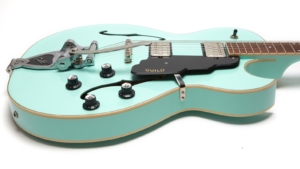 When I received my Starfire I SC I thought that the action was a bit high and the strings were way too big for me (it ships with D’Addario EXL115 Mediums (.011-.049). I replaced the strings, oiled the fretboard (which it didn’t need), polished the frets (which weren’t really a problem), lowered the action and now it rocks. Honestly, it rocks hard.
When I received my Starfire I SC I thought that the action was a bit high and the strings were way too big for me (it ships with D’Addario EXL115 Mediums (.011-.049). I replaced the strings, oiled the fretboard (which it didn’t need), polished the frets (which weren’t really a problem), lowered the action and now it rocks. Honestly, it rocks hard.
Academically, I like the idea of being able to coil-spit either pickup individually, but at first I didn’t think that I would ever do that. Then I realized that having the neck pickup on single coil for rhythm duties and the bridge in humbucker mode for leads could be kind of cool because I could use the selector toggle for a completely different tone. I definitely think the push-pull pots should be on the tone controls, though.
The tone knobs are more or less useless with the only change occurring between 1-2 on the dials, and even then it’s basically a blanket on/off affair.
I think the guitar would definitely benefit from a roller bridge or maybe a TruArc or similar design that lets the Guildsby do its thing more freely. Those Tune-O-Matic bridges just aren’t design for a vibrato bridge.
Sustain is actually pretty impressive on this guitar and I did not find myself wanting in that department. If anything, I’d say tuning would be my main playability complaint and a better bridge would go a long way in improving that.
Conclusion
I tend to be a vintage high-end Guild snob, but the good news is that I’m aware of that bias. I also don’t get paid by advertisers, and I buy all these guitars myself so I am beholden to no one, and honestly, I flat out don’t care who I piss off. I’m telling you all of that because I think it adds credibility when I write that I really like this guitar.
I bought this guitar because it looked cool and I love the color. Call me shallow, but I’d bet a fair number of people, especially first time buyers, do exactly the same thing, especially when considering the price.
Is this guitar perfect? No, but for the money it’s really really good. Yeah, the wiring is not great and I’d probably replace the bridge and maybe the pots (OK, all the wiring), but remember that I’m a collector nut-case with more money than brains. Would I grab this guitar to do a couple of Brian Setzer songs at the local jam? Absolutely! Would I recommend it for a new player? Yes! Would I regularly gig with it? Probably not without replacing the wiring and the toggle (and maybe the push/pull pots). I just don’t trust those parts to be reliable over time. Would I gig with this if I was my 25 year old self who only cared about music because it was a gateway to getting girls? Hell yes.
Yes, the electronics were a disaster, but all of that can be fixed. I’d rather have a well-made guitar with ugly electronics over a guitar with beautiful electronics that wasn’t structurally sound. I have a feeling that with new wiring that this guitar would be a monster. In fact, with everything except the wiring, I had to constantly remind myself that this was a $600 guitar. Hell, for me it was a $450 guitar, and frankly that’s an insane value. Just consider that at some point you may need to have the electronics worked on and you’ll need some sort of case.
In short, I really like this guitar. It’s fun to play, it’s very eye-catching, it plays great, it sounds good, it’s flexible, and I got it for a song. It’s hard to beat that math.
Donate: PayPal Crypto:
ETH: 0x0AC57f8e0A49dc06Ed4f7926d169342ec4FCd461
Doge: DFWpLqMr6QF67t4wRzvTtNd8UDwjGTQBGs

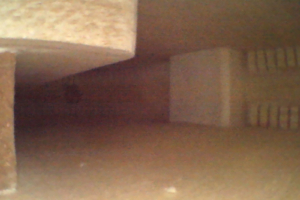
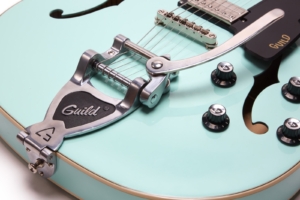
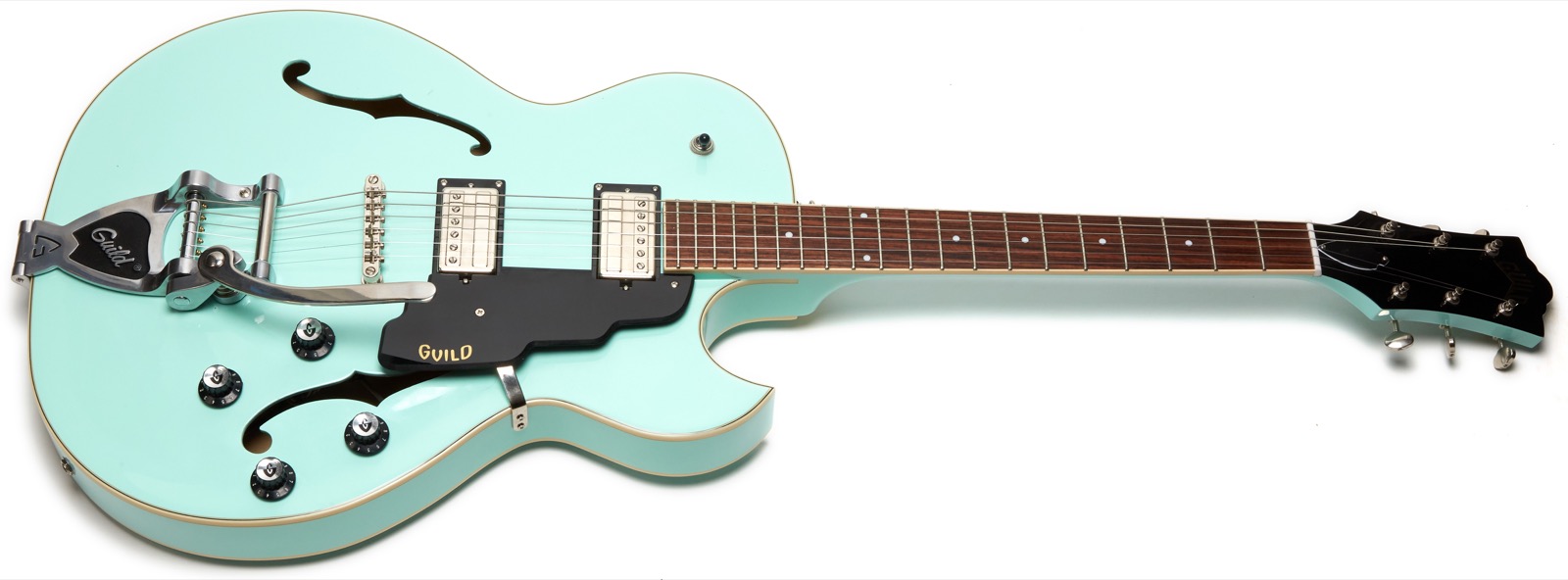
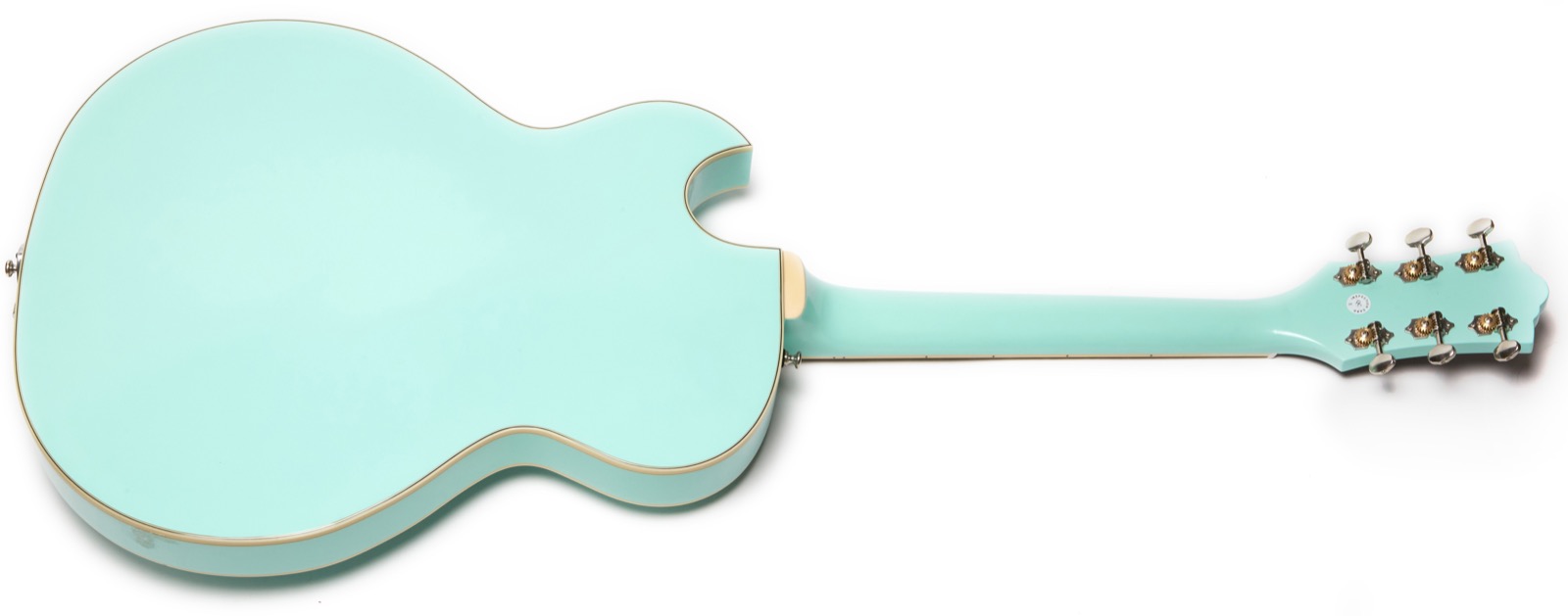
Great review, especially kudos for taking a deep look into the electronics. I agree that Guild/Cordoba should have at least given this more budget line of guitars a different name ala Gretsch w/ the Electromatics and Streamliners. When I went on the Guild website and saw the multitude of “new” models I was thoroughly confused. The most egregious are the NS Aristocrats (which I assume are still MIK (at least for the hollows and possibly MIC for solidbodies. The new solidbody “Aristocrats” are called Aristocrat P-90’s and appear at least cosmetically identical to the older, fully hollow M-75 Aristocrats (and also the Bluesbird body…but more that later). Of course, the Aristocrat P-90’s don’t come w/ P-90’s (as we all know, the Franz pu’s are similar but not P-90’s) and then there is the Aristocrat HH’s (w/ HB2’s). I don’t know this for a fact, but I am guessing that both solidbody Aristocrat models utilize the chambered body of another NS model, the Bluesbird (w/ maybe a slightly different neck set angle to accomodate the Aristocrat bridge and harp tailpiece geometry). That’s about all I can say now as it’s starting to give me a headache. Thanks again for your always great reviews and stay safe and healthy.
Gary: I loved your column Guild Newark St. Starfire I SC Review. When I was young kid I bought a used Starfire III in black. This was around ’66-’67. I loved it, but sold it about 22 years ago. Now I am thinking about getting another, preferably black. My options are a newer one or for some extra $$ an older vintage one like I had as a youngster. I see the newer models, many not USA-made, have a different bridge than my vintage one that had a solid semi-fixed bridge. You could slide this solid bridge up and down a little to adjust for intonation, etc. Since you are an avid collector and Guild aficionado, are the newer versions of the Starfire III anywhere near as good as the original vintage? Or should I spring for a vintage one? Thanks. –Gary, NY
Answered via email
Didn’t you tried this one on a blackface style patch?
Fantastic review. Thank you for all the detail. I love that amount of detail. I was wondering if you could help me with some advice. I bought the walnut version of this guitar, and I have been able to get some fantastic sounds from it. I think it is a beautiful guitar but it really hurts my fingers, in particular my finger joints. I have tried lowering the nut slots and the bridge, then I read you’re info the 12″ fretboard and 9.5″ bridge radius difference. How can I change/ fix this? I ordered the fixed one piece aluminum bridge. Will this work? I play a Gibson J45 with high action which does not cause me the same finger pain. All help appreciated. I’d hate to see it go but if I can’t figure out the reason for the discomfort it will have to find a new home.
Regards
David Smyth
Western Australia
Hey there! Sorry to hear about your hand pain. It’s difficult for me to say what the issue is, but the first thing I would look at is not the fret-board radius, but rather the neck shape – specifically the depth. The Starfire I SC that I reviewed has a neck depth of 0.83″ at the first fret, which while a decent size, isn’t what I’d call huge. If your Gibson has a beefier neck that could be the reason why they feel so different to you.
Looking at Gibson’s webpage, the J45 standard has a neck depth of .83″ which is identical to what I listed, so if that’s the case with yours it could be something else. From what I’ve read the J45 has a bit wider fretboard, but I’d be surprised if that caused you pain.
How’s your grip on the neck? If you’re squeezing really hard as a result of playing an acoustic with a high action, then I’d recommend learning to play with a lighter touch. That can be a hard transition to make but, but it’s very much worth it in the long run.
HTH!
I’ve just bought the same sea foam green guitar, was love at first sight
I’m gunner check the wiring and maybe rectify it if need be, I’m a hobbyist electronic fan so I’m pretty good at soildering wires..
I think mine plays great and sounds amazing but I do agree there’s not much difference on the tone pots but I’ll probably never move em off 10
Didn’t know much about guild guitars but thanks to this article I now do
Great review, thanks. I have the antique burst version without Guildsby. I’ve ordered a tonepros bridge for it (hope I ordered the right one – https://www.thomann.de/gb/tonepros_lpgm02_g_tuneomatic_set_gold.htm ) I got the gold because I aim to get new tuners and well, why not bling it up a bit, can’t do any harm right. I agree about the toggle switch, it’s terrible but as far as the wiring goes I know nothing about wiring though I am able to solder and will be considering what to do with that but haven’t yet even looked at it. Perhaps I can get a ready made wiring loom set already done, I think I’ve seen something like it on ebay UK at some point. so again great review. Thanks
Gary, this is an amazing write up, thank you for your insight! I’m a mainly acoustic player looking for a Guild Starfire, and a frequenter of LTG as well. I was close to pulling the trigger on this one, since I’m really just a hobbyist with electrics and don’t know how much I should be investing. The only thing about this guitar that makes me hesitate is the neck profile – I’m actually looking for something slimmer than that. Do you know of any eras or models of Starfires that have a shallower profile, say in the .80″ or so area at the first fret? I’ve had a ’78 tele for a really long time, and the neck is really skinny and I love it. So if I could find a short scale Guild Starfire with a similar neck, that would be perfect. I also saw your article on the earlier Korean-made Starfires, and see that those necks are a bit thicker than these new ones. So I’m wondering about maybe 1990s DeArmonds, or maybe vintage USA Guilds? I’ve bought guitars off the internet before only to be disappointed by too thick necks, which is a spec not often listed by sellers, unfortunately for me. Much appreciate any advice!
The skinniest Starfire necks I’ve played have all been from the mid ’70s. I had a ’73 that was .79″ at the 1st fret. Many ’80s Guild electrics are in the .80 range, too. Note that they also all have 1 5/8″ nuts.
Really well-written, thanks.
I don’t need another guitar but the SC is cute-looking and I’m shallow and it’s cheap and I’m poor.
I was tempted, but I wanted to get an opinion from someone who knows their stuff, and now I have that,
Hi Gary
Excellent review thank heavens I didn’t read it before I bought one, I might have changed my mind! I’ve had my starfire I SC for about 2 years and I absolutely love it. I agree with all your findings especially the electronics and the bridge.
I am by no means a good guitarist so my opinion is of little weight with regards to this guitars capability but I do use it five nights a week, three hours gigs, playing all sorts of styles (with the help of some pedals) and it’s never let me down.
I intend to continue using it as my daily axe but I would like to improve the electronics, I hate not being able to tweak my tone while playing.
What pots and filters would you recommend? And what wiring setup would be best ?
I love the option of splitting my coils but to be honest a rarely ever use it because there is big reduction in volume and the thinness of single coil disappears in the mix.
Would greatly appreciate the advice.
Charlie
Thanks! Glad you’re loving your Guild!
I generally use CTS or Alpha pots depending on what I need. If by filters you mean capacitors, I don’t subscribe to the “magic capacitor” stuff so prevalent online and am happy to use whatever caps I have around. Some of my favorite Guilds have little orange disk caps in them and they sound great. I have Orange drops in others and RS Electronics super-duper wonder-caps in another and I don’t hear a difference. You’ll get more benefit using 525k pots IMO, which is something I love in a dual humbucker guitar (especially Les Paul types). You can find those from The Art of Tone online.
As for “best” wiring, that’s so subjective I wouldn’t dare suggest anything. People love treble-bleeds, people love ’50s wiring, and a lot of people just play their guitars. 🙂
Hi Gad! Thanks so much for a great and thorough review- appreciated. I am playing the SF 1 SC since two years – the white version – and I’m excited! Great playability, sound, look and super nice alternative and addition to my Gibson ES335! I agree on all your observations, however, when you fixed the wiring issues, did you just fix the soldering or did you change cables? All the best and thanks- and for sure a new fan of Guild!
The review given at the start of this page was very interesting, after owning my first Starfire with De Armond pickups in the UK in the sixties, i took a liking for Guilds and really loved that guitar and especially the pickups, but i have found the same problems that were highlighted in the review with my Starfire 1 dc, the pickups are terrible, and the wiring as described in the review a bloody mess, i have taken the Guild pickups out and am now about to replace them with a different set, and also changed the tone pots, but have to say in addition to the review found problems, if only Guild had made the F holes a little wider so as to make removal of the pots a lot easier, instead of having to remove them through the bridge pickup routing, would have made life a lot easier for everyone concerned, in my books now, Guild have severely damaged their reputation and people remember the bad things always before the good things of a product; Shame on you Guild or should i blame Fender ? P.S. I have also found the 3 way to be faulty.
I have had this guitar for a month and I agree with this amazing write up. (Thank you). I think the wood used for the neck must be “fresh” because it expands very easily. It just take’s the heat produced by the left hand. This guitar goes out of tune just holding it (almost). I assume it may be the same for all modern “affordable” guitars. Lucky I have several 60’s department store guitars that I picked up over the years at thrift stores and these are definitely better made and sound much better than anything I have tried under $1000.